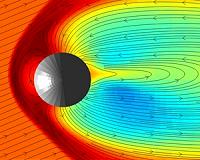 |
Laurel MD (SPX) Sep 06, 2010 The MESSENGER team has just wrapped up a two-week flight test to ensure that the Mercury-bound spacecraft is ready for orbital operations. On March 18, 2011, MESSENGER will become the first spacecraft to enter into orbit about Mercury, embarking on a year-long mission to study in depth the planet closest to the Sun. The completion of this recent test provides a high-fidelity verification of the tools, processes, and procedures that are needed to conduct flight operations at Mercury. "Even though we have more than six months to go until orbit, we wanted to do this test now to make sure that we had enough time to make adjustments," says MESSENGER Mission Operations Manager Andy Calloway, of the Johns Hopkins University Applied Physics Laboratory in Laurel, Md., "But everything worked as expected. We have proven, not just in the ground tests but now in flight, that the sequences and planned daily activities can be conducted safely and as expected. We are quite pleased with the results." The flight test took place from August 17 to August 29. In order to force the spacecraft to rotate in space and to gather science data in a manner similar to the operations the probe will experience during the orbital phase of the mission, the ephemerides used onboard the spacecraft had to be modified. "We had to convince the spacecraft that it was in Mercury orbit," Calloway says. "We also intentionally chose a two-week period with Sun and Earth geometries similar to those that MESSENGER will see during the orbital phase of the mission. The goal was to exercise the flight system in flight conditions as nearly identical as possible to those that will be experienced in orbit to validate performance, and to run as many of the same processes as possible to match a typical fortnight of orbital operations." In support of the two-week flight test, team members worked with NASA's Deep Space Network (DSN) schedulers and engineers to put in place an orbit-like track schedule that is very different from cruise. This schedule consists of daily contacts to play back stored data, upload commands, and monitor vehicle health, while pointing the high-gain antenna at Earth, plus about five hours a day for radio science measurements while the spacecraft points away from Earth and conducts science operations. "During MESSENGER's cruise phase, we typically have had three to four DSN tracks a week, for about six to eight hours each," Calloway says. "But during orbit we will be tracking the spacecraft for 13 hours a day, including weekends and holidays. We needed to see if that was a realistic track schedule and one that we could maintain with our staffing plan, ground tools, and automation scripts." Approximately once a week during orbit, mission operators will perform brief propulsive maneuvers, where they fire MESSENGER's small thrusters to unload angular momentum that builds up in the probe's reaction wheel assemblies due to continuous external forces pushing on the spacecraft - primarily from the Sun. "During the test, they performed three such maneuvers successfully," says APL's Eric Finnegan, the MESSENGER Systems Engineer. "We were able to demonstrate that such momentum management actions can be executed safely and routinely without any impact to science data gathering." During the two weeks of the test, the team also exercised a variety of orbit-like scenarios and activities, including eclipse power management, star tracker management, quick data acquisition, variable downlink data-rate changes, command timing biases, weekly ephemeris loads, bi-weekly command loads, and instrument memory checks. During the second half of the test, the science instruments conducted a series of observations as if the spacecraft were in orbit about Mercury. For example, the Mercury Dual Imaging System collected more than 1,400 images, as if mapping the planet, and the Mercury Laser Altimeter fired four times over the course of two days, as if ranging to the planet's surface. The command sequence directing these activities was generated using the mission's automated science-planning tool, as all sequences will be during the prime mission. "Our entire cruise phase and even the three Mercury flybys have only been warm-ups for the main event of our mission," says MESSENGER Principal Investigator Sean Solomon, of the Carnegie Institution of Washington. "These two weeks of flight tests have been our dress rehearsal, to ensure that our spacecraft and our flight team are ready for opening night."
Share This Article With Planet Earth
Related Links MESSENGER News Flash at Mercury Mars News and Information at MarsDaily.com Lunar Dreams and more
 Extreme Effects: Seven Things You Didn't Know About Mercury
Extreme Effects: Seven Things You Didn't Know About MercuryWashington DC (SPX) Sep 02, 2010 Pity poor Mercury. The tiny planet endures endless assaults by intense sunlight, powerful solar wind and high-speed miniature meteoroids called micrometeoroids. The planet's flimsy covering, the exosphere, nearly blends in with the vacuum of space, making it too thin to offer protection. Because of this, it's tempting to think of Mercury's exosphere as just the battered remains of ancient ... read more |
|
| The content herein, unless otherwise known to be public domain, are Copyright 1995-2010 - SpaceDaily. AFP and UPI Wire Stories are copyright Agence France-Presse and United Press International. ESA Portal Reports are copyright European Space Agency. All NASA sourced material is public domain. Additional copyrights may apply in whole or part to other bona fide parties. Advertising does not imply endorsement,agreement or approval of any opinions, statements or information provided by SpaceDaily on any Web page published or hosted by SpaceDaily. Privacy Statement |